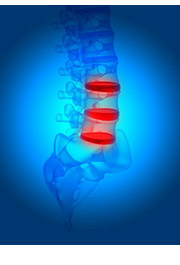Chiropractic for a Herniated Disc
 Herniated discs (HNP) are usually caused by wear and tear of the disc. Other causes are acute trauma, such as lifting, falls or accidents. Herniated Nucleus Pulposus (HNP) is also known as disc degeneration. A liquid jelly material that works it’s way through tears in the cartilage of the disc. This soft cushion of tissue between your spinal vertebrae, is damaged and pushed out abnormally. Our vertebral discs lose some of the fluid that helps them maintain flexibility. This in turn allows pressure to be placed on the nerves of the spinal column itself. As we age the spinal discs become more susceptible to damage during routine movements.
Herniated discs (HNP) are usually caused by wear and tear of the disc. Other causes are acute trauma, such as lifting, falls or accidents. Herniated Nucleus Pulposus (HNP) is also known as disc degeneration. A liquid jelly material that works it’s way through tears in the cartilage of the disc. This soft cushion of tissue between your spinal vertebrae, is damaged and pushed out abnormally. Our vertebral discs lose some of the fluid that helps them maintain flexibility. This in turn allows pressure to be placed on the nerves of the spinal column itself. As we age the spinal discs become more susceptible to damage during routine movements.
Symptoms of a herniated disc vary greatly on the position of the herniated disc and the size of the herniation. Not pressing on a nerve, you may have an ache in the low back or no symptoms at all. When it’s pressing on a nerve you may have pain, numbness, or weakness in the area of your body to which the nerve travels. If the herniation is in the lower (lumbar) back sciatica may develop. Sciatica is pain that travels through the buttock and down a leg to the ankle or foot caused by pressure on the sciatic nerve. Low back pain may accompany the leg pain.
 Our goal is providing patients with treatment to relieve pain or numbness in the lower back (lumbar area) caused by this pressure on a spinal nerve root or the spinal cord. We promote your return to normal activities while preventing further injury to your back. Also reduce the risk of disability from lower back pain. We typically recommend nonsurgical treatments. We may recommend physical therapy with a physical therapist providing treatment with physical or mechanical means. Our chiropractic technique involves manual therapy to manipulate the spine, as well as other joints and soft tissues.
Our goal is providing patients with treatment to relieve pain or numbness in the lower back (lumbar area) caused by this pressure on a spinal nerve root or the spinal cord. We promote your return to normal activities while preventing further injury to your back. Also reduce the risk of disability from lower back pain. We typically recommend nonsurgical treatments. We may recommend physical therapy with a physical therapist providing treatment with physical or mechanical means. Our chiropractic technique involves manual therapy to manipulate the spine, as well as other joints and soft tissues.
Dr. Michael Petrie, D.C.
Spine and Joint Center
